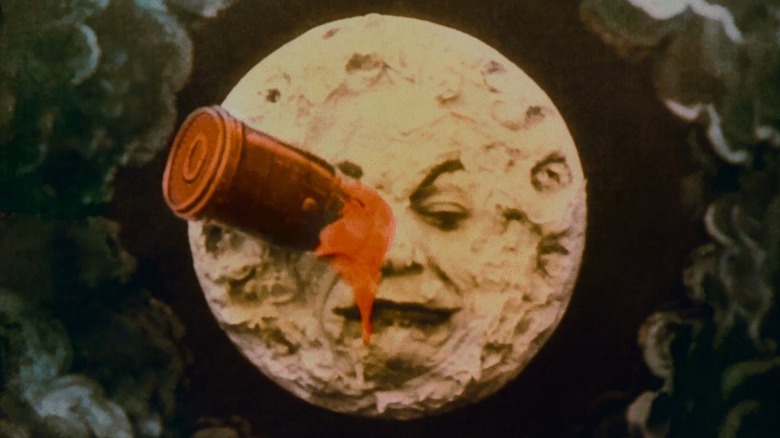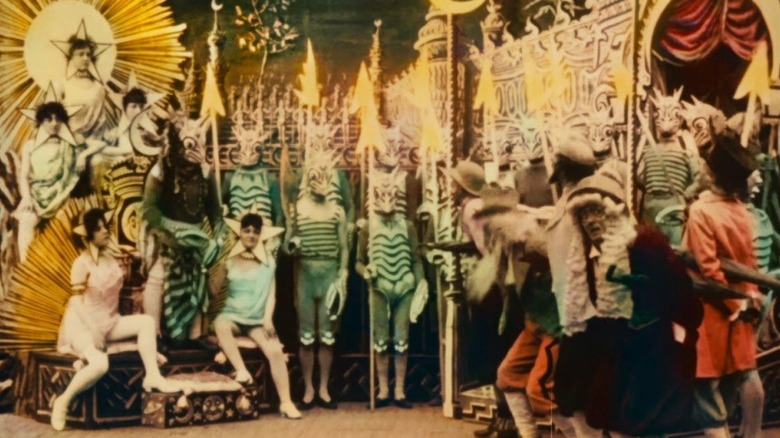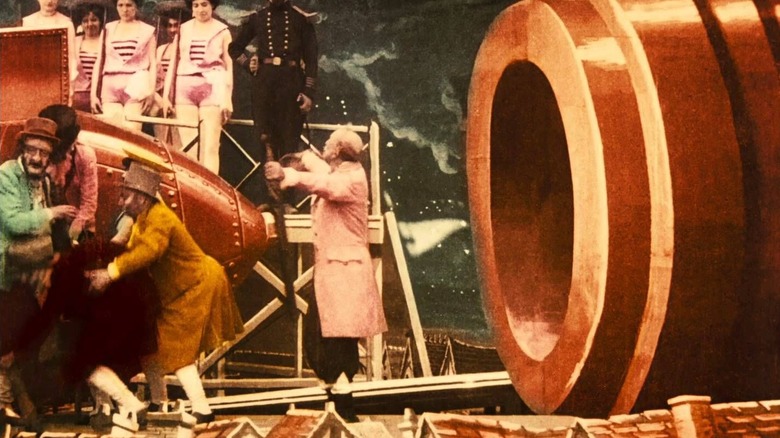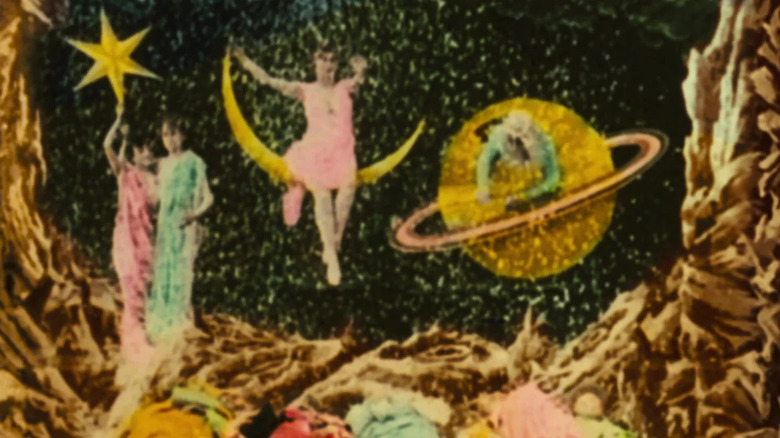This 14-Minute Short Isn't The First Sci-Film, But It Came Close
Most any film school syllabus will likely cite Georges Méliès' 1902 film "A Trip to the Moon" (French title: "Le Voyage Dans la Lune") as the very first science fiction film ever made. Even the British Film Institute lists it as such, citing only a 1901 film called "Mister Moon" as the progenitor, and "Mister Moon" hardly counts as it is merely a musical short wherein actor Percy Honri dresses up as the moon and plays the ukulele. The film was meant to accompany a live performance. Not even the most hardcore sci-fi fans would classify that as "science fiction."
"A Trip to the Moon" is certainly one of the most recognizable silent sci-fi films, and many are likely familiar with the image of the Moon wincing in pain when a human rocket lands in its eye. "A Trip to the Moon" takes a lot of visual cues and ideas from the novels of Jules Verne, particularly 1865's "From the Earth to the Moon" and its sequel, "Around the Moon," published in 1870. Méliès, a bottomlessly imaginative filmmaker, envisioned the Moon as being populated by a species of subterranean aliens called Selenites. Using amazing special effects and clever editing, "A Trip to the Moon" still possesses the power to dazzle audiences and express the astonishing magic of cinema, even 122 years after its making.
"A Trip to the Moon" also comes packaged with an interesting backstory, in that it was lost for many years, and only rediscovered in the 1930s when Méliès, then in his 70s, was recognized as an important pioneer of the medium. "Moon" is an important movie, and film students should continue to study it and be dazzled by it.
It was, however, not the first sci-fi movie ever.
A little more about 'A Trip to the Moon'
Before we get to the first sci-fi film ever, we can indeed pause to talk about "A Trip to the Moon" because it is astonishing, and no sci-fi fan would be well-versed in the genre without studying it. Also, it could be argued that "A Trip to the Moon" is more of a fantasy film than sci-fi, as it more closely resembles a magical tale like "The Wizard of Oz" more than it does "The Martian." "A Trip" takes place in a fantastical version of Earth whereon a high-end astronomy club aims to shoot a rocket to the moon. Méliès plays the leader of the club, Professor Barbenfouillis. He and five other astronomers — bearing the awesome names of Nostradamus, Alcofrisbas, Omega, Micromegas, and Parafaragaramus — leave Earth with a lot of fanfare and land on an oxygen-rich lunar landscape covered with vegetation.
When the astronomers sleep, they are visited by a passing goddess who causes it to snow. Fleeing the snow, the astronomers hide out in a mushroom-encrusted cave. In the cave, they encounter a buglike Selenite who takes them to the moon's throne room to meet the king. The astronomers found that they could thwack Selenites over the head and cause them to explode. They kill off a few of the locals, run back to their capsule and, in a marvelous piece of physical comedy, tip the capsule off the moon, causing it to fall back to Earth.
Méliès was clearly more enamored of fantastical dream imagery, special effects, color, and costume than he was with science. But, because it involves a rocket to the moon, we accept it as a precursor to the oncoming Space Age.
The pre-'Moon' movies
And, yes, "A Trip to the Moon" was presented in color. Prints were shot in black-and-white and then sent to a specialized coloring lab in Paris. Méliès selected very specific hues, and a team of colorists would paint them directly onto the developed film stock. Hand coloring and tinting were common in the silent era.
But "A Trip to the Moon" wasn't the first sci-fi film. Indeed, it wasn't even Méliès' first sci-fi film.
If one is to trust the Aurum Film Encyclopedia, the first sci-fi film ever was "The Mechanical Butcher," a short made by the Lumière Brothers in 1895. The Lumières, as all first-year film students know, invented the Cinématographe motion picture system, one of the earliest motion picture cameras, making them among the very first filmmakers. "The Mechanical Butcher" is only 53 seconds long, and depicts butcher characters lifting a pig into a futuristic machine and extracting it as prepared pork products. Mechanized slaughterhouses were relatively new in 1895, and the Lumières made a short depicting the absurdity of sped-up, high-tech meat manufacture. Why, only a moment ago, these pork chops were alive! If sci-fi is a genre that analyzes technology's effects on human development — techno-anthropology — then "The Mechanical Butcher" certainly counts.
If one wants a sci-fi film about a technology that hasn't been invented yet, then one might want to learn about Méliès' first sci-fi film "Gugusse and the Automaton" from 1897. This film is sadly lost, but it was about a clown meeting a robot (although the word "robot" wouldn't enter the lexicon until the publication of Karel Čapek's 1921 play "R.U.R."). "Gugusse" marks the first time a robot ever appeared in a movie.
The turn of the 19th century
Still surviving, luckily, is George Albert Smith's 1897 film "The X-Rays," a.k.a. "The X-Ray Fiend." Running only 45 seconds, Smith's film is about a would-be dandy trying to romance a young woman when they are both struck by an X-ray. They briefly become skeletons while the romancing continues. When the X-ray turns off, the woman rebuffs the man and storms off. "The X-Rays" was right up to the minute in terms of examining technology; X-rays had only been discovered in 1895.
The 1890s weren't free of artists ripping off each other, and one year after "The X-Ray Fiend," Méliès made "A Novice at X-Rays," another film lost to time. Sadly, the content of "A Novice at X-Rays" is unknown, but we can safely assume that it also took advantage of the nascent technology.
Also in 1898, Méliès made a three-minute film called "The Astronomer's Dream, or the Man in the Moon." This film was more like Christopher Marlowe's "Doctor Faustus" than anything by Jules Verne, but it is about a scientist who, upon falling asleep, dreams that he is being attacked by the moon. Like many of Méliès' films, "The Astronomer's Dream" is more concerned with effects and fantastical dream images than science or rationality. If we're tracing the history of the genre, however, it's important to mention.
In 2011, Martin Scorsese directed a 3D kid-friendly film called "Hugo," about a young boy who lives in a train station in 1931. The boy discovers that a local cantankerous shop owner is actually Georges Méliès (Ben Kingsley), and the fun kid adventure soon becomes a treatise about the importance of film preservation. For those needing an introduction to Méliès, "Hugo" is a great place to start.



